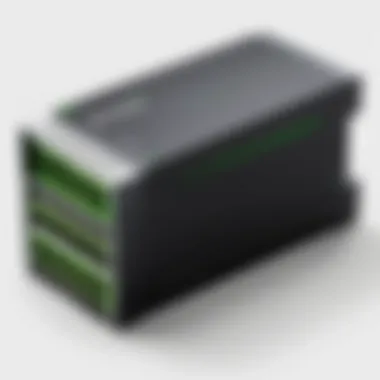Understanding Meraki Firewall Licensing Costs: A Guide


Intro
The topic of Meraki firewall licensing is increasingly important for organizations seeking robust cybersecurity solutions. Understanding the financial dynamics behind these licenses is fundamental for decision-makers, IT professionals, and entrepreneurs. This article will thoroughly explore the essential features of Meraki firewalls, various licensing options, and the elements that could influence costs beyond the sticker price.
For any organization considering investment in network security, clarity regarding licensing costs is critical. This entails examining not only the direct costs associated with acquiring a license but also the potential hidden expenses, subscription models, and ongoing operational costs.
In the following sections, we break down key software features and comparison metrics to provide a solid foundation for informed financial decisions.
Key Software Features
Understanding the features of Meraki firewalls helps in comprehending their licensing costs. The software exhibits several functionalities that vary based on the licensing model chosen.
Essential functionalities
Meraki firewalls provide a range of essential functionalities that can meet the needs of various business environments. These include:
- Intrusion Prevention System (IPS): Protects the network by identifying and blocking potential intrusions.
- Content Filtering: Ensures compliance with organizational policies by blocking inappropriate web content.
- VPN Support: Facilitates secure remote access for employees, which is increasingly vital in today's work environment.
- Network Visibility Tools: Allow administrators to monitor traffic, users, and applications to optimize performance and security.
Advanced capabilities
In addition to the essential functionalities, Meraki firewalls offer advanced capabilities that can foster more comprehensive security strategies. Such capabilities include:
- Application-based Policies: Enable granular control over application traffic, allowing businesses to prioritize mission-critical applications.
- SD-WAN: Enhances network performance and reliability by intelligently directing traffic over multiple connections.
- Machine Learning Integrations: Improve threat detection and response times through ongoing learning from network behaviors.
These features, while valuable, also play a significant role in determining the overall cost of licensing Meraki firewalls. The complexity and capabilities required will influence licensing decisions.
"A clear understanding of the Licenses offered by Meraki can significantly impact budget and operational planning."
Comparison Metrics
To ensure that investments in Meraki firewall licenses are justified, an understanding of how to analyze these costs is necessary. Various metrics must be weighed against individual business goals to find the best fit.
Cost analysis
When assessing the cost of Meraki firewall licenses, several factors come into play:
- Initial License Fee: This first step often represents the largest upfront cost. Organizations must evaluate budgetary constraints carefully.
- Subscription Duration: Licensing can be structured as monthly or annual subscriptions, with costs varying significantly based on the length of commitment.
- Scalability Costs: As a business grows, additional licenses or upgrades may be needed, thus increasing the overall costs.
Performance benchmarks
Performance should never be overshadowed by cost. Analyzing performance against cost helps in understanding value.
- Bandwidth Management: Measure the effectiveness of bandwidth allocation compared to costs incurred.
- Security Incident Responses: Track response times and effectiveness as a reflection of the firewall's ability to manage threats, aligning this with licensing costs.
Preface to Meraki Firewalls
In a corporate environment, network security is crucial. One of the central figures in achieving this is the firewall. Meraki firewalls stand out in the market due to their unique capabilities and licensing structures. Fully comprehending these offerings lays the foundation for strategic decision-making concerning network safety. This section dissects Meraki firewalls, underscoring their significance for organizations looking to bolster their digital defenses.
Overview of Meraki
Meraki, a Cisco subsidiary, provides a variety of networking solutions including firewalls. Its systems are cloud-managed, which ensures easier control and management from any location. Meraki firewalls combine multiple functionalities such as intrusion detection, VPN support, and application visibility. This integration allows businesses to streamline their security efforts, creating a more cohesive infrastructure.
Organizations appreciate Meraki’s user-friendly dashboard. This feature gives administrators real-time insights into their networks through intuitive displays. Additionally, scalability is another noteworthy benefit. Firms can start with a few devices and expand as needed, making it a suitable choice for both small businesses and large enterprises.
However, understanding the licensing costs is a key part of adopting this technology. Prospective buyers must evaluate various factors such as the type of license needed and potential hidden costs that might emerge during the deployment phase.
"A well-informed approach to licensing can significantly impact the overall effectiveness of your Meraki firewall deployment."
Ultimately, a thorough understanding of Meraki firewalls provides insight into how they can enhance an organization’s security posture while assisting in more effective budgeting and resource allocation.
Types of Meraki Firewall Licenses
The types of Meraki firewall licenses play a crucial role in understanding their overall cost structure. This section not only covers the specifics of each license type but also emphasizes their implications for businesses. Choosing between the available licenses can significantly affect network security, management capabilities, and financial planning. Each license type comes with distinct features and pricing models that can influence how a company approaches its cybersecurity strategies.


Enterprise License
The Enterprise License is aimed at organizations that require standard firewall functionalities combined with network management capabilities. This license offers core features, including basic security, access control, and traffic management. The simplicity of this license makes it suitable for small to medium-sized businesses that might not need advanced security measures.
One of the main benefits of the Enterprise License is its cost-effectiveness for those looking to implement robust network security without the added complexity. However, decision-makers should be aware that while the Enterprise License covers essential needs, it may not provide extensive protection against sophisticated cyber threats. The cost of the Enterprise License can vary, and companies must consider the potential need for upgrades in security features as their business grows.
Advanced Security License
For businesses confronted with escalating cybersecurity threats, the Advanced Security License is a more fitting option. This license includes additional features such as advanced threat protection, intrusion detection, and malware defense. Organizations operating in regulated industries or those with sensitive data may find this license indispensable.
Investing in the Advanced Security License can lead to increased peace of mind, knowing that their network is monitored and protected against a wider range of threats. However, the cost implications are considerable. Organizations choosing this license must budget accordingly to not only cover the initial expenditure but also ongoing subscription fees. The financial analysis for this license should account for potential losses due to security breaches if the cheaper, basic options are considered.
Meraki Licensing Tiers
Meraki offers various licensing tiers that cater to different organizational needs and budgetary constraints. Understanding these tiers is essential for effective resource allocation. The tier-based system allows businesses to select a licensing option that aligns with their specific operational requirements.
These tiers can be broken down into the following categories:
- Basic Tier: Covers fundamental functions and is suited for simple network setups.
- Standard Tier: Offers additional features over the basic tier, appealing to businesses requiring moderate capabilities.
- Premium Tier: Provides full-featured access, ideal for large enterprises or those needing advanced functionalities.
Each tier reflects a mix of capabilities that can affect the overall cost structure of Meraki firewalls. Therefore, companies must assess their current and future needs to make informed decisions regarding which licensing tier best aligns with their objectives. Decision-makers should also consider how these choices impact not only financial considerations but also potential growth and scalability of their cybersecurity framework.
Factors Affecting License Cost
Understanding the costs associated with licensing Meraki firewalls is crucial for any organization planning to invest in these network security solutions. Several factors play a significant role in determining the overall expense linked to acquiring and maintaining these licenses. By examining these factors, businesses can make informed decisions and effectively allocate their resources to optimize their investment. The importance of understanding these cost factors cannot be overstated; it directly influences the budgeting and financial planning processes within organizations.
Number of Devices
The number of devices to be included under a Meraki firewall license has a direct impact on the overall cost. Each device presents its own licensing requirement, and the more devices you have, the higher the cumulative fees will be. This means that small businesses with just a few devices may find the initial investment manageable, while large enterprises with multiple devices need to approach budgeting differently.
- Consideration of device numbers:
- A single license can cover multiple Meraki devices such as security appliances and wireless access points.
- Bulk licensing may offer discounts, but initial costs can still be high for multiple units.
It is wise to conduct a thorough inventory of all necessary devices, as this will inform the financial implications of your firewall licensing. A logical plan for device integration and licensing will also prevent potential unexpected costs down the line.
Duration of License
The duration of the Meraki firewall license is another determinant of cost. Organizations can opt for a variety of license durations, typically ranging from one to five years. A longer commitment often results in discounts compared to short-term licenses.
- Key insights regarding duration:
- Annual licenses might lower initial costs but can result in higher cumulative costs over time.
- Multi-year licenses encourage budget predictability since they lock in prices for extended periods.
Decisions about the length of the license commitment must also consider future growth. Organizations expecting significant expansion may want to choose longer licenses now to hedge against future cost increases.
Included Features
Meraki firewall licenses come with different features depending on the type of license purchased. The feature set directly influences the price and can include essential functions like security updates, threat management, and support services.
- Aspects to consider regarding features:
- Basic features usually cover fundamental security needs but may lack advanced security protocols.
- Advanced features, on the other hand, may include additional capabilities such as deeper analytics and premium support options.
Choosing a license with the appropriate features to match your organization's specific needs helps avoid overpaying for unneeded capabilities or under-licensing critical security measures.
Subscription Models
Understanding the subscription models for Meraki firewall licenses is essential for businesses planning their cybersecurity expenditures. These models dictate how organizations allocate budgets over time and significantly influence cash flow.
Annual Subscription
An annual subscription model offers flexibility and relatively lower upfront costs. Organizations choose this model to manage expenses effectively while ensuring that they have access to the latest features and security updates. The payments occur once a year, which can help in planning and forecasting expenses.
Benefits of Annual Subscription:


- Lower Initial Investment: Fewer resources are tied up at the beginning, making it financially manageable for companies.
- Access to Updates: Subscribers get immediate access to new features and security patches, ensuring the infrastructure remains robust against threats.
- Scalability: As business needs shift, adding more licenses or features becomes more straightforward.
However, businesses should also consider potential downsides, such as annual renewal negotiations and the pressure of yearly budget allocations. Furthermore, the commitment to a yearly fee can bind companies to service plans that they may need to reevaluate as their needs evolve.
Multi-Year Agreements
Multi-year agreements present a different approach with longer-term commitments and often lead to discounts for the extended duration of service. These contracts not only secure a consistent level of service but also help stabilize costs over several years, which can be advantageous for budget planning.
Considerations for Multi-Year Agreements:
- Cost Savings: Companies often enjoy reduced rates compared to annual subscriptions. This model may yield significant long-term savings.
- Predictability: Businesses benefit from a stable cost structure, allowing for precise financial planning and resource allocation.
- Long-Term Support: Multiyear contracts typically come with strong support options, ensuring that organizations have what they need as they grow.
Nonetheless, this model also introduces risk. If business needs shift dramatically during the term of the agreement, companies may find themselves locked into solutions that no longer align with their strategies.
Overall, whether opting for annual subscriptions or multi-year agreements, understanding the implications of each model is crucial. Decision-makers should carefully analyze both current and future technology needs and financial capacity.
Hidden Costs Associated with Licensing
When evaluating the cost of Meraki firewall licenses, it is imperative to consider the hidden costs that might not be immediately apparent. These costs can significantly influence the overall financial commitment. Hidden costs often include not just the price of the licenses themselves but also aspects related to installation, maintenance, and support services that can add to the total cost of ownership. A thorough understanding of these hidden costs is essential for decision-makers to create accurate budgets and make informed choices when investing in security solutions.
Installation Fees
Installation fees can be a considerable hidden cost when deploying Meraki firewalls. Depending on the complexity of the network infrastructure, the installation process may require specialized knowledge and skills. There can be several associated charges:
- Labor Costs: If you hire external professionals for installation, their fees can range based on expertise and location.
- Configuration Expenses: Configuring the firewall to meet specific business requirements may incur additional labor costs.
- Pre-Deployment Assessments: Assessing the current network setup for compatibility with the Meraki firewall can also lead to additional charges.
Being mindful of these expenses ensures that a business is not just focused on the license fee but understands that installation can escalate costs significantly.
Maintenance Costs
Maintenance costs encompass ongoing expenses necessary to keep the Meraki firewall in optimal condition. These costs can become a significant part of the overall financial commitment:
- Regular Updates: Keeping the firewall updated with the latest software and security patches is crucial for performance and security and can come with costs depending on the service agreement.
- Hardware Maintenance: Depending on the agreements in place, hardware may require periodic maintenance or replacements, which should be budgeted for as well.
- Compliance Checks: Many businesses must adhere to regulations that involve regular checks and updates, which can add to the maintenance costs.
Organizations must account for their long-term budgeting and reliability in terms of securing their network effectively.
Support Services
Support services are another area where hidden costs can arise. While many Meraki licenses include basic support, there can be additional charges for premium services:
- Technical Support: Access to dedicated technical support may come at an additional fee, especially for critical incidents requiring immediate attention.
- Training and Onboarding: Training staff to effectively use the Meraki firewall may not be included in the license cost and can require investment in both time and money.
- Additional Resources: Sometimes, organizations need more resources, such as additional software or personnel, to effectively utilize the capabilities of the firewall.
Understanding the potential costs associated with support services helps businesses align their resources and ensures the network is managed effectively.
It is essential to evaluate these hidden costs realistically. They contribute significantly to the total cost of ownership and should be considered in the budgeting process.
Comparative Pricing Analysis
In the realm of network security, the choice of a firewall solution can significantly impact both operational efficiency and budget. Thus, conducting a comparative pricing analysis is an essential step for decision-makers looking to invest in Meraki firewalls. This analysis not only uncovers the broader market landscape but also highlights the unique positioning of Meraki products in relation to their competitors. An informed comparison enables businesses to ensure they are making a sound investment tailored to their specific needs.
When comparing Meraki to other firewall solutions, several specific elements warrant attention:
- Cost Structure: Understand how the pricing of Meraki firewalls contrasts with alternatives. Some competitors may offer lower upfront costs but hidden fees can inflate long-term expenses.
- Features Offered: Evaluate the features included in each license type. Meraki's Advanced Security License, for instance, includes extensive security measures that may not be present in other vendors’ offers. Thus, a seemingly lower price may lead to higher expenditures on additional features that are standard in Meraki solutions.
- Support and Maintenance: Review what is included in terms of support services. Meraki's cloud-based management often means better ongoing support with fewer additional costs compared to traditional alternatives where support may come at an added price.
Engaging in this pricing analysis can yield various benefits. First, it encourages a comprehensive understanding of options available, thus allowing for strategic decision-making. Second, it can assist in highlighting areas where Meraki may provide superior value.
Considerations during this analysis should include not just the immediate pricing, but long-term value. Examining contracts, renewal policies, and the price for additional features or upgrades can offer a holistic view of total expenditure on the network security solution. This can ensure firms are choosing a firewall that not only meets present requirements but also scales as needs evolve.
Meraki vs. Competitors
When examining Meraki against competitors, the overall value offering becomes crucial. Products such as Fortinet's FortiGate and Palo Alto Networks firewalls often serve as the main rivals.
Certain notable aspects arise during such comparisons:


- User Interface: Meraki's intuitive user interface simplifies management significantly compared to other complex systems that require extensive training.
- Integration with Existing Infrastructure: How well a firewall integrates with current systems can affect costs related to implementation. Meraki's solutions are known for seamless integration, which may save both time and financial resources.
- Scalability: Consider how each product can grow with your organization. Meraki's cloud model allows for easy scalability without substantial investment in hardware.
In summary, conducting a detailed comparative pricing analysis is crucial when contemplating Meraki firewall solutions. Organizations that invest time in this analysis are likely to find opportunities to optimize their spending while maximizing their security posture.
"Comparison between firewall solutions can illuminate the path towards the most effective investment, balancing cost with service quality, and feature set."
This approach boosts confidence in decision-making and ensures that resources are deployed in the wisest manner possible.
Cost-Benefit Considerations
Considering the cost-benefit analysis when investing in Meraki firewall licenses is essential for any organization. This analysis helps decision-makers weigh the financial investment against the expected benefits of the firewall solution. By evaluating both the costs involved and the potential gains, organizations can make more informed decisions, ensuring they derive maximum value from every dollar spent. The importance of understanding cost-benefit considerations extends beyond mere expense tracking; it informs strategic planning and resource allocation.
Return on Investment
Return on Investment, or ROI, is a crucial metric for businesses that want to ascertain the effectiveness of their Meraki firewall deployment. True value is not just in the initial purchase price but in how effectively the solution protects network assets and supports operational efficiency.
Investing in Meraki solutions usually means lower operational costs due to the integrated features and ease of management. A well-implemented firewall can prevent costly data breaches, network downtime, and other cyber threats that can derail operational efficiency. To calculate ROI, a business can use the formula:
ROI = (Net Profit / Cost of Investment) x 100
The calculation may include various factors such as reduced incidents of cyber-attacks, lower IT support costs, and improved compliance with regulatory standards.
Factors that contribute positively to ROI include:
- Enhanced network security reducing potential losses from breaches.
- Efficient management resulting in lower staffing needs.
- Increased user productivity due to fewer disruptions from attacks.
Long-Term Savings
Long-term savings associated with Meraki firewalls are equally significant. While the initial investment might seem substantial, the long-term financial implications often reveal a different story. Businesses can achieve these savings through several avenues:
- Scalability: Meraki solutions are designed to grow with the organization. This means that as the company expands, it does not need to invest significantly in new hardware.
- Reduced Maintenance Costs: Meraki's cloud-based management reduces the need for onsite IT staff and the associated overhead costs, allowing for a leaner operational approach.
- Consolidated Features: Many advanced features come bundled with the licenses, negating the need for multiple third-party solutions which can drive down costs.
By factoring in the long-term savings into the cost-benefit equation, companies are often surprised by how quickly investments in Meraki products can pay off. Understanding these financial implications is vital for any organization looking to invest in network security without sacrificing future budget flexibility.
Making an Informed Decision
In the context of Meraki firewall licensing, making an informed decision involves evaluating various aspects that can significantly impact overall costs and operational efficiency. A deliberate approach will help organizations avoid potential pitfalls associated with inadequate planning and unexpected expenses. This section highlights key elements crucial for understanding the financial and strategic implications of licensing.
Evaluating Business Needs
Identifying the specific needs of a business is fundamental before any investment in firewall solutions. Organizations must clearly define their security requirements and operational goals. This evaluation should include:
- Current Infrastructure: Assess what existing systems and devices are in place. Understanding your environment aids in determining how Meraki firewalls can integrate seamlessly.
- Scalability Requirements: Consider how needs might change in the future. If growth is projected, it's prudent to select a licensing model that allows for easy scalability.
- Compliance Standards: Depending on the industry, certain regulatory requirements may exist. It is essential to ensure that the chosen firewall solution meets such standards.
Properly evaluating business needs not only aids decision-making but also safeguards against overspending on unnecessary features.
Assessing Total Cost of Ownership
The total cost of ownership (TCO) for Meraki firewalls extends beyond initial licensing fees. Accurately calculating TCO is essential for making sound financial decisions. Here are the primary factors to consider:
- Initial License Fee: This is the upfront cost required to acquire the license. Knowing this is crucial, but it is only one part of the equation.
- Recurring Costs: Evaluate the subscription fees, maintenance, and support services over the lifespan of the firewall. These recurring costs can add significant amounts to the overall expenditure.
- Operational Efficiency: Analyze how well the firewall performs. A more effective firewall can reduce downtime or security breaches, leading to lower indirect costs over time.
By thoughtfully assessing TCO, organizations can gauge the true financial commitment associated with Meraki firewalls, leading to more fiscally responsible choices.
"Understanding both business needs and total cost of ownership is key to optimizing value when investing in Meraki firewall solutions."
Making informed decisions regarding firewall licensing ensures that investments align with organizational goals and budget constraints. Proper analysis enables long-term planning that can lead to notable cost savings and improved security posture.
Finale
In summary, the discussion around Meraki firewall licensing costs conveys a nuanced landscape that requires careful navigation. Understanding the intricacies of these costs is paramount for any organization looking to invest in Meraki solutions. This final section encapsulates the essence of the considerations outlined throughout the article.
One significant aspect is the variety of licenses available. The distinctions between the Enterprise License and the Advanced Security License can affect budgeting strategies. Decision-makers must recognize not only the initial costs but also the long-term implications tied to features and overall coverage.
Additionally, subscription models play a crucial role in shaping the total cost. Options such as annual subscriptions or multi-year agreements can have different impacts on cash flow and financial planning. Organizations should evaluate their operational requirements in line with these models to optimize their investment.
Moreover, hidden costs are an often overlooked but vital element. Installation fees, maintenance, and support services can accumulate, thus, individuals involved in financial planning must account for these in their calculations. A complete breakdown of expected expenditures can prevent budget overruns.
Ultimately, the process of assessing total cost of ownership must be central in discussions surrounding Meraki firewall licenses. An informed decision requires not only an understanding of the direct costs but also a holistic view that encompasses all potential expenses associated with maintaining the firewall.
"The right licensing strategy can enhance security while ensuring resource allocation aligns with overall business goals."



